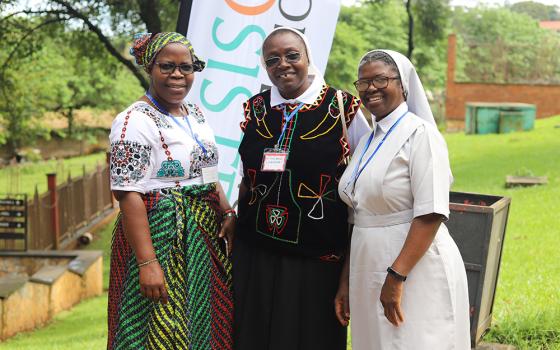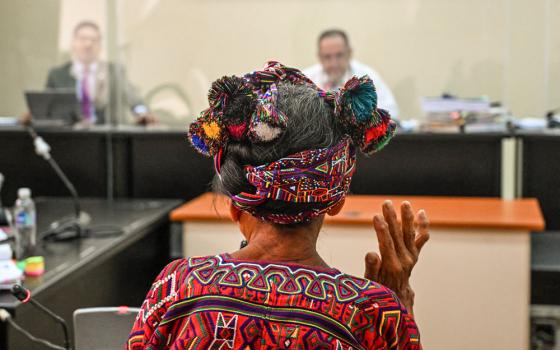
The visitation of Mary and Elizabeth was full of love. Luke tells us that Mary hastened to a Judean town in the hill country to visit Elizabeth. Elizabeth, filled with the Holy Spirit, greeted Mary with the words, “Blessed are you among women.” Mary in turn acknowledged God’s goodness as she dared to say, “The Lord has done great things for me. Holy is God’s name.”
Apostolic Visitations, unlike the visitation between Mary and Elizabeth, are not celebratory occasions. “Visitation” in this context has taken on the meaning of “investigation.” Recent Apostolic Visitations by the Holy See include the visitation of United States seminaries and houses of formation for men in response to the sexual abuse of children by priests and the question of the perceived relationship of homosexuality to that scandal, and a visitation of the Legionnaires of Christ in various countries because of sexual improprieties of the order’s founder.
According to Cardinal Franc Rode, C.M., prefect of the Vatican’s Congregation for Institutes of Consecrated Life and Societies of Apostolic Life, the purpose of the current visitation of the sisters is “to look into the quality of life of apostolic Congregations of women religious in the United States.” Women religious who are in contemplative or cloistered congregations are not included in the visitation; nor are male religious.
“Quality of life” is difficult to measure. Literature on the official website of the visitation,, hints at what it means by quality when it describes the “objectives” of the visitation as to “encourage the growth of Catholic Institutes of women religious in the United States who engage in apostolic works.” Quality of life is not ordinarily related to the number of sisters, but that connection has been made on the Apostolic Visitation web page.
It is true that the number of sisters has decreased. In 1966 there were approximately 181,000 Catholic sisters in the United States, the great majority of them belonging to apostolic as distinct from contemplative congregations. Today there are approximately 59,000 sisters in apostolic congregations. The foundational question is what has caused the decrease in numbers. There are many such possibilities, including a change in both cultural and church realities. The decrease in numbers may or may not be related to the quality of our lives.
“Quality of Life”
How can we measure the quality of our lives. We might ask how to assess the quality of a marriage, or the quality of life of priests, or the quality of life of those who are poor, or those who are successful. In every case the quality of life will be related to other persons. How do a husband and wife relate to each other? How do they relate to their children? to the community in which they live? to the nation of which they are citizens, to the church which they are?
In the beginning of my life as a Dominican sister the quality of my life was quite different from the quality of my life today. The pattern of daily life was stable. I lived in a community of sisters in a convent located close to the parish church. Our community chanted the Office of the Blessed Virgin Mary each morning and each evening. We walked to the church each day for Mass. Our daily schedule included time for meditation, spiritual reading, study, and recreation together. We ate our meals in silence, listening to spiritual reading at supper. We were teachers in the parish school. Life was prayerful. It had a daily rhythm and a focus.
We lived according to our Constitution, a document approved by the official Church. At that time the first article in our Constitution stated that we “should be found uniform . . . in all observance of Religion in order that the outward uniformity of our practice may both represent and maintain the inward unity which should exist in our hearts.” Uniformity was what was most evident to our parishioners. We each had our own talents and temperaments but those differences were sometimes hidden behind separation and uniform observances.
By the time I was ready for retirement I was teaching in a graduate program at a university in California and living with one other sister from our congregation. Both of us taught at the same university. Often we taught at different times, one early in the morning, the other in the evening. The university celebrated eucharist each day at noon. Prayer, meditation, spiritual reading, study and sharing meals together were integral parts of our daily life but we were often unable to do them together.
Today the first article in our revised Constitution begins with the words, “The life of the Trinity is the source of mission.” Within thirty years we moved from emphasizing uniformity as a sign of our unity, to recognizing that the true source of our unity is the divine life God shares with us. It is the Holy Trinity who unites us.
Changes Begin
In 1950 Pope Pius XII initiated changes in religious life. In a letter to the prefect of the Sacred Congregation for Religious, Cardinal Micara, the pope noted the need for adaptation and renewal in religious life, lest “the holy laws of each Institute degenerate into an assemblage of exterior regulations uselessly imposed, whose letter, in the absence of the spirit, kills.” The Congregation called for a meeting of Superiors General of religious congregations in Rome (Nov. 26 – Dec.8). The theme of the conference was the renewal and adaptation of religious life.
At that meeting Pope Pius XII asked the 4000 superiors to reduce “whatever nonessential and archaic customs were hindering their apostolates.” He noted that some practices were essential to develop the spirit of an order, but others were not necessary as they were extrinsic, historical practices. In Sponsa Christi, an exhortation on Religious Life, Pope Pius XII decreed that superiors ought “to introduce cautiously and prudently those adaptations to present day conditions which will be able to bring not only greater dignity but also greater efficacy” to the institutes.
Pope Pius XII also recommended changes in sisters’ clothing, calling for a religious habit that was “simple and modest, poor and at the same time becoming.” He said that the habit “must be suited to the circumstances of time and place and to the needs of the ministry involved.” He believed that “it was the strangeness of outdated costumes and customs and the strain of being sent into ministry without proper training . . . that was behind the alarming drop-off of religious vocations in Europe after World War II.”
The Council’s Call for Renewal of Religious Life
In 1962 the Second Vatican Council began and the lives of all Catholics began to change. Most sisters watched the opening and closing sessions on television, read conciliar documents, mourned the death of Pope John XXIII and looked forward to the leadership of Pope Paul VI. In response to the Council many Catholics began to live the Gospel in a renewed way. The 1960s were for many of us full of hope and new life, both new intellectual life and a renewed spiritual life.
Our congregations kept us up-to-date on conciliar developments. Council experts gave lectures throughout the country and many of us listened to those lectures on audio tapes. Cardinal Leon Suenens challenged women religious to reconsider their lives through his book, The Nun in the World (1963). He startled many of us with his statement that, “The world of women ought to appear to a nun’s eye as a mission field entrusted to her.” He told us that we need to know clearly what is essential in the Church and what is incidental. New questions emerged, including what is essential and what is incidental in religious life.
At the final session in 1965, the Council approved The Decree on the Adaptation and Renewal of Religious Life. This decree directed religious to do three things, 1) to return to the sources of Christianity for guidance, 2) to return to the original spirit of our founders, and 3) to adapt ourselves to the changed conditions of our time. After the Council, Pope Paul VI issued norms for the implementation of the Decree on Religious Life.
One norm called for general chapters of religious congregations to make allowance for adequate and prudent experimentation, and it recommended that superiors “should hear the members of the Order in those things which concern the future well being of the whole institute” The chapters could alter norms of the constitutions and permit experiments contrary to the common law.” (Norms, article 4).
The sisters took the prescriptions of the Church through the Council and pope seriously. Many sisters, though not all, were enthusiastic about renewal. We had no idea where this obedience would take us, nor did the whole Church, including curial officials and the laity. Only the Spirit knew where we would be led.
The Response of the Sisters
With tremendous energy religious congregations and individual sisters moved to reassess their lives. A new emphasis on adult and other forms of religious education led some sisters to move or be moved by their superiors from the schools into diocesan offices and to parishes without Catholic schools. Other sisters moved into different forms of social ministry in response to the opening words of Gaudium et Spes:
We moved into the neighborhoods of those who are poor so we might educate them, learn from them, help them navigate the complex roads of government and societal programs. Many women recognized us as women who could understand them and reached out to us to share both their joys and sorrows.
In response to the Council’s request that sisters return to the “sources of all Christian life,” congregations sent sisters to study the Scriptures and theology. Many institutes assigned sisters to graduate study in biblical studies, theology, spirituality, liturgical studies, catechetics, Church history, canon law. Women religious became highly educated in these disciplines and began to teach them in colleges and universities. Now some women are professors in some of the finest theological schools, a reality forbidden until the last half of the twentieth century.
The admonition to honor the spirit and aims of our founders made us re-examine our historical beginnings. We asked what our founders wanted of us. How did they foresee us preaching the Gospel and serving the Church? Sometimes sisters realized that their founders or foundresses were the object of hostility or contempt from their bishop, or had themselves been expelled from the congregation they founded. At other times the spirit and aims of the founder were denied by bishops or Roman congregations. The founding path was not always smooth.
Sisters renewed themselves through new forms of prayer. Many congregations began to pray the Liturgy of the Hours each morning and evening. Sometimes parishes in rural towns or geographic areas where there were no sisters, sought our services and we went to those places, lived alone, and tried to figure out new ways of experiencing both the riches and the difficulties of community living. In many cities community life became difficult because convents were no longer available as housing for sisters.
Our revised Constitution set forth in written form that which gives birth to the quality of our lives. For twenty to thirty years sisters reworked their constitutions to establish realistic goals for their congregations. They then submitted these renewed constitutions for approval to the Vatican Congregation for Institutes of Consecrated Life.
The Holy Spirit renewed us as we struggled together to fulfill our mandate. We did make mistakes. We have struggled to find unity in the midst of differences. Renewal was costly. We are not perfect, but we set our goal high, to follow Christ as set forth in the Gospel, through the Church and our founders, in today’s world. “The life of the Trinity is the source of mission.”
One Sister’s Perspective
I cannot speak for other sisters or other congregations, but one of the rewards of renewal is the way in which various congregations of sisters have worked together harmoniously. I believe we share a common culture as well as a shared faith which compels us to live as we do. While other congregations may have experienced renewal differently and while sisters in my own congregation also responded uniquely, I do believe we share a common culture as well as a common faith.
As I consider the purpose of the Apostolic Visitation many more questions enter my mind than I have addressed here. I know that many sisters are perplexed and saddened by the action taken by the Vatican Congregation. Is it possible that Vatican authorities and some of our bishops may not know the guidelines we were asked to follow? Many of the men who are bishops today were forty-five years younger when we were given these directions.
We did what the Church asked us to do and we have been renewed in faith and hope and love. I am convinced that the quality of our lives today is more deeply rooted in Gospel values than it was in an earlier time.
Voices of support
The voices of many Catholics have been strong and consistent in support of the sisters. Year after year Catholics have been most generous in their financial contributions to the retirement fund for the sisters, and I do not know what we would have done or will do without their generosity. We believe they must be as puzzled by this Visitation as we are.
We also hear voices of support from thousands of women and men who are associate members of our congregations. Associates join congregations of sisters in prayer, in study, and in support of our ministries because they find value in our lives. They share our spirit. They grow in faith with us and they strengthen our faith.
Associates give us a new vitality and I believe they are a sign of our own vitality.
Sisters are also grateful for the unequivocal support of the International Union of Superiors General, whose membership comprises nearly 2,000 leaders of congregations of apostolic women religious. After learning of the Apostolic Visitation these sisters publicly affirmed their support for “our sisters in the United States.”t
The first visitation was full of love. Elizabeth presumed Mary’s faithfulness and Mary in turn acknowledged God’s goodness to her as she dared to say, “The Lord has done great things for me. Holy is God’s name.”
So say we all. “The Lord has done great things for us. Holy is God’s name.”
Dominican Sister Anne Marie Mongoven is a sister of Sinsinawa, Wisconsin, and a Professor emerita from Santa Clara University, Santa Clara, CA.



